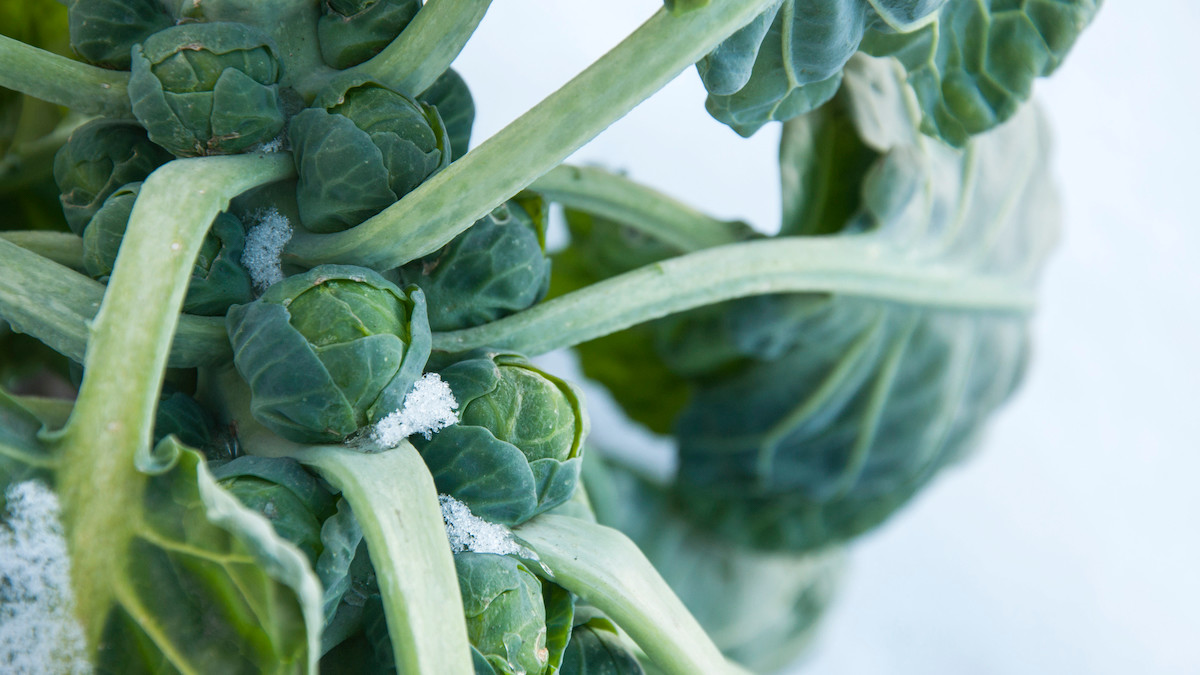
As the name implies, brussels sprouts were first cultivated in what is now Brussels, Belgium, around the beginning of the 16th century. The fact that individual sprouts resemble tiny cabbages is no coincidence; they were originally bred from the exact same species as cabbage (Brassica oleracea). The primary difference between the two plants is that the farmers selectively bred for a bunch of tiny buds on the brussels sprouts instead of the one giant one like cabbage.
Kale, broccoli, kohlrabi, and other familiar cool weather crops were also cultivated from Brassica oleracea; only in these cases the farmers selectively bred for enlarged leaves (kale), enlarged flower heads (broccoli), and enlarged stems (kohlrabi). Plants of this species are often referred to as being in the “cabbage family.”
Brussels sprouts are an eye-catching vegetable and a great treat for home-gardeners and homesteaders. If you follow the guidelines below, you’ll have a pile of these bite-sized morsels in your garden in no time.
Growing Conditions Brussels sprouts are a relatively slow-growing vegetable. Most varieties take between 90 and 120 days to mature and are typically harvested after the first frost. To figure out when to start your seeds, you should find out the exact number of days to maturity for the variety you are growing and use that to count backwards from your average first frost date. Brussels sprouts will grow in most places in North America, but they thrive in cooler northern climates with a long fall. In warmer climates in the deep South, brussels sprouts may appear short and stunted, and as I’ll explain later, the flavor will be inferior to those grown in a colder environment.
Brussels sprouts are typically grown from seed in a seed-starting soil mix and then transplanted into the garden when they have three or four true leaves. Depending on the size of the variety you are growing, you should space your plants anywhere from 18 to 24 inches apart in the beds. They are fairly shallow-rooted, so it can also be beneficial to add some mulch around the base of each plant; this is especially important if you live in a dry environment.
Pests and Disease Brussels sprouts are susceptible to the same familiar pests as other crops in the cabbage family such as cabbage moths, slugs, and flea beetles. These pests can be removed with organic broad-spectrum pesticides such as pyrethrin, but a more effective method of preventing insect pressure is to cover the plants with row cover when they are young and vulnerable to attack.
Flea beetles and cabbage moths both fly to find their victims, and as long as they aren’t present when you place the row cover on the plants, they won’t be able to access them once the row cover is applied. In the case of slugs, the best organic method that I have found is to hand-pick them at night with a flashlight for two to three nights in a row to reduce their population and repeat that process if you begin to see slug damage again. Brussels sprouts are also susceptible to the same diseases as other plants in the cabbage family, so avoid planting crops in that family in the same place year after year. The same holds true for most other crops, so sticking to a good crop rotation is generally a smart idea.
Harvest and Storage As I mentioned above, brussels sprouts often taste better when they are grown in colder environments. Frost kills sensitive plants by causing the water inside their cells to freeze, expand, and physically burst through the cell walls. This is why frost-killed plants often look bruised, as if somebody smashed all the leaves between their fingers. Brussels sprouts and other plants in the cabbage family have adapted to overcome this and extend their growing season by lowering the freezing point of the water in their cells. This is accomplished by converting some starches in the cell into sugars and generating compounds called “antifreeze proteins” when the weather begins to cool down.
This increase in simple sugar is why people generally agree that plants in the cabbage family taste sweeter after the first frost. It’s also a possible explanation for why deer will sometimes ignore brassica-heavy food plots until the weather cools down and then suddenly become interested in them.
When and how you harvest your brussels sprouts depends on personal preference, but generally you want them to be at least the size of a pecan to maximize the harvest. Once you have removed the sprouts from the plant, they can last for a few weeks fresh in a refrigerator or you can freeze them for long-term storage. As long as they’re protected from pests, you can also simply leave your sprouts in the garden through the late fall and early winter and harvest as needed.







